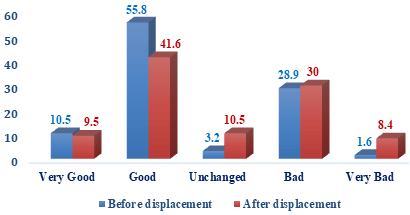Rural to urban migration of disaster induced displaced people in coastal area of Bangladesh: An analysis of risk and opportunity
Main Article Content
Abstract
Displacement is the earlier concept of civilization but climate induced displacement is the contemporary issue as climate victim of modern and industrialized world. The prime aim of the study was to investigate the rural to urban migration of disaster induced displacement in coastal area of Bangladesh addressing to risks and opportunities. The study mainly based on primary data and secondary data was used for validation. Primary data have been obtained through the quantitative along with qualitative sources. Qualitative data were attained through Participant Observation, Key Informant Interview (KII) and Focus Group Discussion (FGD) methods. Quantitative data have been acquired through the field study consisting of a questionnaire survey. Data were interpreted by the Statistical Package for the Social Science (SPSS-20). The study reveals that after displacement nearly 89% displaced people migrated from rural (Kutubdia Island) to Cox’s Bazar urban area. Consequently, meantime their monthly income, occupational status, housing and sanitation condition, source of drinking water and health care facilities were changed positively but in most cases they are dissatisfied. Because they lost their traditional and indigenous occupations system (after migration nearly 30% dissatisfied about their occupation but before migration it was 16%) and their housing pattern and conditions become worsen. Availability of water and sanitation facility and healthcare seeking behavior changed positively in the urban area. However, in urban area they faced multi-dimensional problems such as harassment by mussel man (14%) and local elite group influence (32%), loss of identity and dignity, freedom of speech, social stratification, loss of socio-cultural harmony and fear of eviction as well as involvement of different types of illegal activities, such as drug addiction and smuggling and so on. Finally, the study revealed that there is risk and opportunity for climate displaced people in urban migration. However, planned migration of disaster induced displaced people can reduce the risk factors in the urban setting.
Article Details

This work is licensed under a Creative Commons Attribution-NonCommercial 4.0 International License.
References
- Morton A, Boncour P and Laczko F. Human security policy challenges. Forced Migration Review, 2008, 31: 5-7. https://www.fmreview.org/climatechange/morton-boncour-laczko
- Displacement Solutions. Climate Displacement in Bangladesh: The Urgent Need of Housing, Land and Property Rights, 2012. https://displacementsolutions.org/latest-news-on-climate-displacement-in-bangladesh
- Rabbani MG. Climate forced migration: A massive threat to coastal people in Bangladesh, Clime Asia: Climate Action Network-South Asia newsletter, BCAS, Dhaka, 2009.
- CDMP-II 2014. Trend and Impact Analysis of Internal Displacement due to the Impacts of Disaster and Climate Change, Comprehensive Disaster Management Programme, Ministry of Disaster Management and Relief, Dhaka, 2014.
- The Guardian 2013. Sea change: the Bay of Bengal’s vanishing islands.
- Shahjahan M and Barua P. Climate Displacement in Bangladesh: Need Urgent Actions. Social Change, 2014, 4(1-2): 81-89.
- Islam N. An Introduction to Research Methodology, University Press Limited, Third edition, Dhaka, Bangladesh, 2014, 162-165.
- BBS. Bangladesh bureau of statistics, Ministry of Planning, Government Republic of Bangladesh, Dhaka, 2011.



